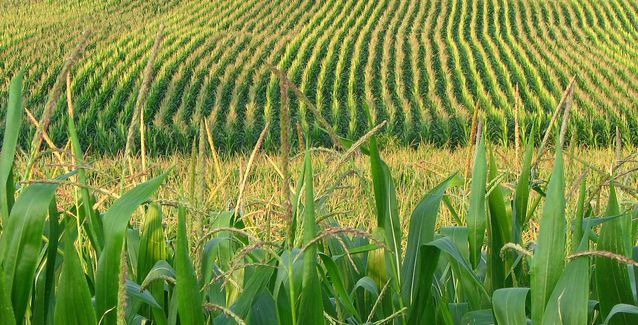USDA predicts corn, soybean acres to soar; rice to plunge
by May 2, 2021 3:48 pm 1,932 views

There has been growing optimism through the late spring and early summer that several row crops, including soybeans and corn, might add acres in 2021. The expectations are becoming a reality after the release of the U.S. Department of Agriculture’s annual Prospective Plantings Report.
The report, conducted by the USDA’s National Agricultural Statistics Service, reflects producers’ intended acreage for crops across the country based on a survey of about 78,900 farm operations.
Soybean prices were up 70 cents a bushel, and corn up 25 cents — the respective market limits for daily price increases on those commodities, following the release of the report. Cotton prices increased by more than a dollar per hundredweight, closing at $80.10 per cwt. As of the last week in April, soybean prices were trading well above $13 per bushel, a six-year high according to Food Business News.
The higher prices are being fueled by greater demand and optimism that the COVID-19 pandemic will be under control this year. Rice crop acres are predicted to plunge as other crop prices rise.
Scott Stiles, extension economist for the University of Arkansas System Division of Agriculture, described the markets as “running red hot” in the wake of the USDA publication. This has trickled to Arkansas farms.
Soybeans
In Arkansas, soybeans, the state’s top crop, rose 6% to hit a planned 3 million acres. Jeremy Ross, extension soybean agronomist for the Division of Agriculture, said that acreage forecast may be low.
“From talking to soybean producers, I would expect the soybean acreage to be higher than the 3 million acres projected,” Ross said. “Especially, if we get some good weather.”
Nationally, soybean acreage increased 6% to about 87.6 million acres.
Corn
Arkansas corn saw a substantial increase of 13% to 700,000 acres. Jason Kelley, extension wheat and feed grains agronomist for the Division of Agriculture, said the rising market prices for corn at the end of 2020 were expected to prompt greater acreage this year.
“With good planting weather over the next couple weeks I would think 700,000 acres could be easily achieved,” Kelley said.
Nationally, corn acreage gained only 1%, rising to about 91.1 million acres. Ironically, both soybean and corn acreage fell short of industry expectations, Stiles said.
“Ahead of the report, the average industry guess for soybean acres was right at 90 million,” Stiles said.
The final number was up 5 million from last year, but not the number the trade was expecting.
“U.S. soybean supplies are very tight going into 2021,” he said. “87.6 million does not increase ending stocks. The market emphatically said today it has to reach for more acres. Similarly, 91.4 million corn acres is not expected to increase ending stocks either. There’s a fierce competition now between corn and soybeans for acres. Soybeans really need to pick up 2.5 million more acres to increase stocks just marginally in 2021.”
Cotton
Even as prices have risen for cotton, planned acreage for the state dropped 7% from 2020’s 525,000 acres, down to about 490,000 acres. Bill Robertson, extension cotton agronomist for the Division of Agriculture, said the decrease in acreage reflected the comparative ease — and lower input costs — with which corn and soybeans can be successfully grown.
“You really have to borrow a lot of money to plant cotton or rice,” Robertson said. “There’s just a lot of risk involved. It’s much cheaper to plant corn, and cheaper still to plant soybeans.”
Nationally, the change in planned cotton acreage was essentially flat, falling less than 1% from 2020 acreage to about 12 million acres.
Rice
Planned rice acreage declined significantly in Arkansas and across the United States. Arkansas growers reported intended acres at about 1.25 million acres, a 14% drop from 2020’s approximately 1.46 million acres. Nationally, planned rice acres fell 11%, to about 2.7 million acres.
Jarrod Hardke, extension rice agronomist for the Division of Agriculture, said the decline in Arkansas rice acreage met industry expectations. He said he had expected acreage to be down 10% at a minimum.
“Further decreases would depend on rotational crops and prices,” he said. “A good April planting window will be key to keeping the acres in the report, as planting delays will likely give way to more soybeans given the current price situation there.”
Peanuts
Peanuts, while still a relatively small player in Arkansas commodities, continued its steady, years-long gains, increasing by 15% to 45,000 acres. Andy Vangilder, agriculture and natural resources educator for the Cooperative Extension Service, said the increasing number of buying points in Arkansas and neighboring states has made the crop more attractive to producers who might otherwise grow cotton.
Peanuts “have continued to be profitable as long as the weather cooperates,” Vangilder said. “I know that Delta Peanut has shown interest in attracting new customers and adding some more acres if producers are interested.”
Futures market prices for corn, cotton and soybeans all rose 32%, 32% and 38% in year-over-year comparisons, respectively. Rice futures also rose year-over-year, but at a more modest 8%.
Overall, crop acreage in Arkansas rose about 1.4% over 2020 acreage.
